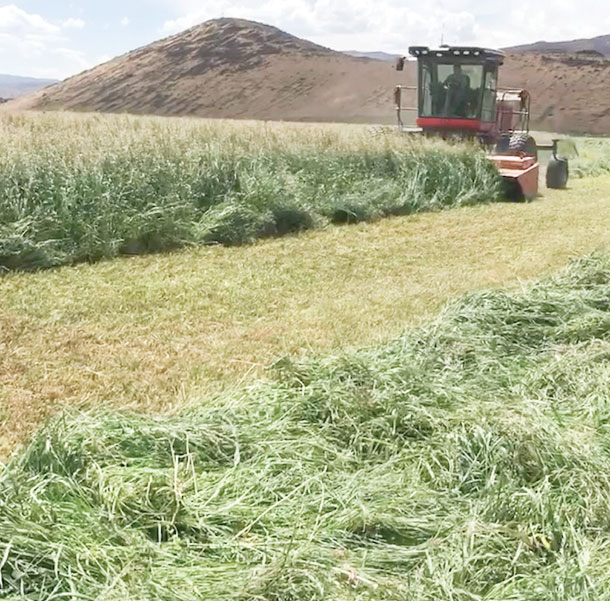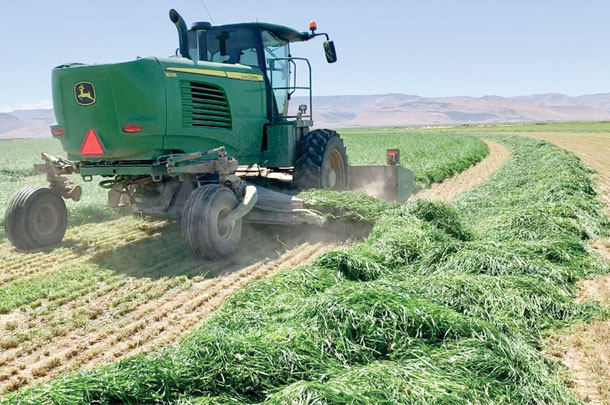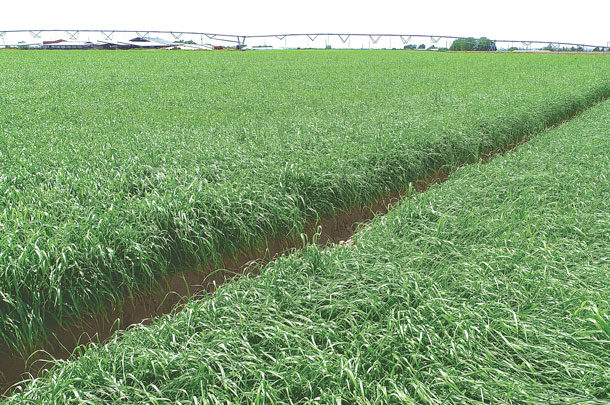New forage varieties are filling gaps in the grazing calendar with perennial pastures or cover crops, enabling cattle to graze more of the year or providing higher-quality forage for beef production or dairy.Bryan Weech, market development manager with Barenbrug USA, says research and technology have brought new genetics to market.
Beef cattle options
The 6666 Ranch in Texas has 13 pivots of a mixture for weaning calves on good-quality grass. “They wean about 9,000 calves in October or early November, grazing them until January or February,” says Weech.
Jed Bateman of AgriSource (Burley, Idaho) is a seed distributor and works with farmers and ranchers in Idaho and Utah to determine which seed mixes might work best for them. One farmer in northern Utah had challenges with high salt levels in soil and high pH. “We used several seed mixes with poor success, then last year changed his cropping system to no-till with less soil disturbance. For seed, he used 30 pounds of triticale and a perennial mix containing soft-leaf tall fescue, orchardgrass and perennial ryegrass with new genetics,” Bateman says.
“With soil cover and minimum disturbance, he got good pasture established. The best thing for pasture establishment is diversity. The more species you add, especially for a tough situation, the better all of them react, and seem to have a symbiotic relationship and help each other,” he says.

A field planted with a seed mixture developed for dry conditions is cut for hay in a year that had a fair amount of moisture. Photo by Jed Bateman.
In another creative scenario, an Idaho rancher was trying to produce more forage while establishing perennial pasture. “Three years ago, he planted oats for hay – and again the next year with a perennial pasture seeded underneath, using oats as a cover crop,” says Bateman. After harvesting the oat hay, the new pasture was about 3 inches tall and well established.
“By then, it was July 20, and we thought we could do a lot more while waiting for this pasture to grow. We put in another cover crop – a diverse mix of radishes, a two-way forage turnip and forage brassica, Italian ryegrass, red clover and sorghum-sudangrass [a warm-season grass that could handle hot weather]. We no-tilled those seeds into the young grass, and the rancher started grazing in late October. He pastured cattle that fall for almost 100 days, and it didn’t hurt the perennial pasture. That was our big concern, but he needed more pasture going into fall, and this diverse mix provided it. The next spring, the permanent pasture was thick and full. We triple-cropped that ground while growing permanent pasture,” Bateman says.
A similar thing can be accomplished with grazing corn. “The permanent pasture mix grows beautifully underneath it. The grass takes a beating during winter, grazing the corn, but in the field we tried last year there’s a 95 percent stand of pasture,” says Bateman.
There are also seed mixes for dry ground. “If ranchers need something that will work if they run out of irrigation water in late July, we use a mix called Barricade; it has five species of dryland grasses, some of which were developed in our dry region. This mix was developed in conjunction with research from USDA-ARS; we used some of their plant material in the mix,” Bateman says.
It includes Artillery smooth brome, which was developed in northern Utah, plus Arsenal meadow brome, Hakari Alaska brome, intermediate wheat grass and Drover tall fescue. It thrives on dry years, but when it gets more rain it produces even more.
Weech says this mix does well in climates with 12 to 18 inches of annual precipitation but also works well in areas with limited irrigation. Many Western ranches have water early in the season but not in late summer. “If they only have spring runoff for irrigation, this gets the plants going, and they perform well through drier months of late summer, even when other pastures dry out and lose quality,” he says. Some ranches have early water for irrigation and take a cutting of hay and then grow it back for pasture, even if the season is hot and dry.
Dairy options
Several new seed mixes are working for dairies. One of these is a new variety of Italian ryegrass. Bateman says it gives dairymen another option beyond corn, alfalfa and cereal grain. Fiber digestibility is as high as 70%.

On Wybenga Dairy in Cassia County, Idaho, the second cutting begins on a newer variety of Italian ryegrass developed for dairies. Photo by Jed Bateman.
“Here in the Magic Valley [Idaho], we’ve had problems with overwintering, but in many places, it overwinters very well. We’re trying to figure out ways to get two years out of it. As a biennial, the first year it stays vegetative and doesn’t produce a seedhead. It grows continually, and farmers get three to four cuttings. We plant in April and usually take first cutting at the end of May or early June. It establishes quickly,” he says.
“One large dairy fresh cuts several hundred tons per day, working across five pivots. That farmer gets another two days of feed in the Italian ryegrass fields beyond what he gets with alfalfa,” says Bateman.
Some people plant this in the fall and get a cutting in late fall, plus early spring production. They may utilize it in spring and early summer and take it out in time to put in a summer annual or corn. In Idaho, some farmers are mixing it with brassicas like turnips or a forage rapeseed. Some farmers seed it by air into corn when the corn is knee-high, or by using a three-point spreader on the back of a tractor. It germinates and sits under the corn canopy, then after the corn is harvested, the young plants grow quickly, with a big flush of forage. Some people put stockers on it, or developing heifers, because it is high-quality pasture.
Forages for different climates
In hot, humid areas like Missouri, Kentucky and Tennessee, the main forage is tall fescue. “Traditional tall fescue [like Kentucky 31] has always been infected with endophyte fungus. It is hardy and grows well but hinders cattle performance,” says Weech.
“To address these issues, we have a line of endophyte-free soft-leaf tall fescues which are very high quality. We’ve also developed a product with a strain of endophyte that is beneficial to the plant but does not create the challenges for livestock. You get a hardy plant that is adaptable and persists but not so detrimental to cattle performance,” he says.
Various ranches around the country have success stories with innovative forages to extend their grazing season. “Deseret Ranches started a trial with us and USDA-ARS Forage and Rangeland Research Lab to improve pasture quality. Sieben Livestock at Cascade, Montana, is extending their grazing using some of this technology.”
The Padlock Ranch in Wyoming is doing a study with Bayer, using herbicide to control cheatgrass, then planting a mixture that requires less water to replace the cheatgrass so it won’t come back. “We are also using a new seed mix designed for even drier climates,” says Weech.












